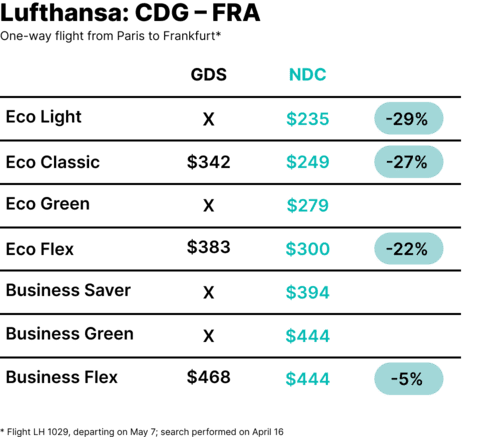How NDC is shaking up airfare pricing and saving companies money
Ed Brooks

The transition to New Distribution Capability (NDC) is accelerating, driven by airlines seeking more flexibility when distributing their content. While airlines get more control and flexibility over their fares, NDC represents an opportunity for companies to benefit from greater cost savings. In what is likely the most extensive study of NDC booking data published to date, Navan studied how NDC is shaking up airfare pricing and what it means for company travel programmes.
The impact of NDC on airfare pricing
At its core, NDC gives airlines more flexibility when distributing their content, and provides travellers with richer content and a better shopping experience. It represents a step away from EDIFACT, a legacy airfare distribution protocol from the 1980s, which has fewer price points and less flexibility to provide personalised offerings.
With NDC, airfare pricing is more in line with what’s available when booking directly with airlines. Compared to legacy channels, pricing curves are much smoother — and the same fare can cost up to 60% less on NDC-enabled channels. Customers with NDC access see potential savings per airline ranging from 3.3% to 16.6%.
How airlines are driving NDC adoption
As the industry accelerates its transition to NDC, the impact on companies who are unable to access this content is felt in different ways:
GDS surcharges
As airlines move away from legacy channels, many are adding fixed GDS surcharges to all non-NDC agency bookings, either per ticket or per segment, to incentivise NDC adoption. GDS surcharges vary per airline and can significantly impact the cost of a flight, as shown below:

Additional price points
NDC offers more flexibility in terms of pricing structures, with smaller gaps between price points. The result is a smoother pricing curve and more competitive fares than EDIFACT, which can result in significant price gaps between EDIFACT and NDC — even if the booked fare is ultimately the same.
To better understand this, we can look at an example from British Airways below. Here, we compare the least expensive Eco Standard fares available via EDIFACT and NDC on three one-way flights from London to Frankfurt:

Via the GDS, all three flights were available at the same price: $223. Via NDC, each flight is priced differently, with fares ranging from $196 to $207.
Booking one of those flights via NDC can unlock savings ranging from 7% to 12%, preventing overspending of up to $27 for a single flight.
Exclusive fares
Many airlines are making the most of NDC’s retailing capabilities to create unique travel offers. They are also removing fares from GDS EDIFACT channels, with basic economy usually the first to go. For instance, more than half of Lufthansa Group fares on many routes are often exclusive to direct or NDC channels.
For companies without access to NDC, this means increased travel budgets and platform leakage from travellers who are tempted by cheaper or more convenient fares available on the airline's website.
In this example, we look at fares available via NDC and the GDS for a Lufthansa flight from Paris to Frankfurt:

Only three of the seven fare options are available via the GDS, and they are considerably more expensive. For this flight, companies without NDC are missing out on four out of seven available fares (57%). At the time of our search, the lowest available fare was 29% less expensive via NDC — a potential savings of up to $107 on a single booking.
Companies are already making big savings
As airlines move away from the limitations of legacy distribution channels and further enrich their travel content, travel programmes with access to NDC content stand to benefit through having access to the often lower-priced fares and additional travel options.
Some Navan customers are on track to make six-digit annualised savings, with potential savings of between 3.3% and 16.6% depending on the airline, thanks to avoided GDS surcharges and access to additional price points and exclusive fares.

FTSE 100 company Informa, for example, is on track to save around $215k over the course of 2024 thanks to having access to 15 NDC connections with the likes of British Airways, KLM, and American Airlines.
Melissa Watson, Group Travel & Corporate Events Director at Informa, says: “With all the changes in the industry, we needed a platform that was agile enough to accommodate new technology and processes. Informa is now seeing good savings from NDC via Navan; we’re on track to save around $215k this year. More needs to be done, but we are happy that access to NDC fares is gaining momentum.”
Access to NDC: a must-have for companies
It’s clear that NDC is shaking up airfare pricing, with airlines largely driving the changes and setting the pace of NDC adoption. With most major airlines already offering differentiated NDC content or planning to do so soon, what was once a nice-to-have is now a must-have for companies with employees who travel regularly for business.
At Navan, we saw the enormous potential of NDC and moved early to enable NDC connections with airlines, including 12 in Europe alone. NDC now accounts for one-third of all flight bookings made in Europe with Navan.
Get the full report to dive into many more NDC insights, including a detailed breakdown of the overall savings opportunities per airline and a closer look at what NDC looks like with each carrier.
Ready to see how Navan’s NDC connections can ensure your company gets all the air content it needs? Book a demo today.
This content is for informational purposes only. It doesn't necessarily reflect the views of Navan and should not be construed as legal, tax, benefits, financial, accounting, or other advice. If you need specific advice for your business, please consult with an expert, as rules and regulations change regularly.
More content you might like
Take Travel and Expense Further with Navan
Move faster, stay compliant, and save smarter.